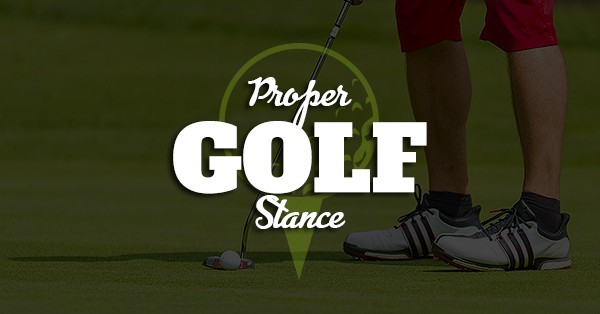The Ultimate Guide to a Proper Golf Stance
by Bill Winters
Everyone has their own unique golf stance. Just exactly how you stand while addressing the ball can have a huge effect on your game – from the subtle spacing between your feet to the perfect bend of your knees. A good swing can’t happen without the right setup. But there are so many different setup components to consider if you’re trying to figure out what works best for you.
Honestly, if you’ve been playing for a while, you may not think much about it. I know I’m guilty of this – I have a stance that I just fall into naturally and without much thought. But it’s never a bad thing to review the basics and do a little reevaluation. So, if you’re interested in learning about the best golf stance, read on.
Contents
The Importance of a Proper Stance

Golf isn’t just about swinging. Your posture and the way you address the ball can change the way you swing.
By thinking about the way you stand and making adjustments to ensure you have the correct posture and are paying attention to the right details, you can add power and control to your shots. Pros like David Leadbetter and Jack Nicklaus tend to agree that the initial setup is the foundation of a good shot – it separates the good from the bad.
But just how do you figure out the best stance to improve your game?
Finding The Right Address Setup
In this section, I’ll go over all the physical factors you should think about when getting into your setup position. You’re probably already familiar with the best upper body posture practices. However, there are tons of smaller details to think about regarding your legs, feet, and positioning.
Let’s go through all the key elements of a good stance from the ground up.
Ball Positioning & Alignment
Before you know how to stand, you have to find where it’s best to stand in relation to the ball. Where precisely you choose to address the ball will primarily depend on what club you’re using and what distance you’re aiming to shoot for.
Many golfers have differing opinions on where exactly to stand in reference to the ball. I recommend to placing the ball forward of the center of your stance. The ball should be inching more and more forward the farther you intend to send it and the longer your club. In general, many find between two and four inches from inside your leading foot is the ideal spot for the ball. Lots of golfers also take a “club first” approach, where they line up their clubs with the ball and then use that to find out where to stand.
Alignment is all about where your body is in relation to the target line. Ideally, every part of your body – your shoulders, your knees, your hips, your feet – should start off parallel to the target line. By keeping yourself evenly and sufficiently aligned to the target line, you’re setting yourself up for a more controlled swing.
Figuring out just where and how you address the ball requires a lot of plain old trial and error to find out what works best. Every golfer has a different preference, and it’s up to you to find out yours.
Feet
Your feet should be placed shoulder-width apart with weight evenly distributed between them. That means no rocking forward to put tension on the balls of your feet, but don’t lean so far back that you’re on your heels.
A good way to test if you’re evenly distributing your weight is to stand on a flat surface and try lifting up your toes a little bit. Then try that again with your heels. If you lose your balance one way or the other, your weight isn’t even.
Your feet should be facing straight in front of you – don’t get duck-footed or pigeon-toed. Try instead to line your feet up perpendicular to the target line. This helps you with your balance, keeping you steady and fully grounded. Some find turning their rear foot slightly outwards helps open their backswing. You shouldn’t sacrifice balance to do so and you shouldn’t turn it out more than a few degrees.
In general, the width of your feet will change slightly depending on your club length. The longer the club, the wider your feet are apart (but only open them up a few inches). Inversely, the shorter the club, the closer your feet are together (but again, only a few inches). If you’re a bit older like me or just have a lesser range of mobility, you might find it easier to keep the distance between your feet narrower than what’s commonly recommended.
Knees
Bend or flex your knees slightly. Not so much that it’s uncomfortable, but certainly don’t lock your knees or keep them totally loose. Ideally, they should be directly over the balls of your feet, no more, no less. Your knees should never extend over the toe of your shoe; doing so can lead to injury. If you feel pain when your knees are bent slightly, that’s a sign you should be doing more stretches and light exercises to strengthen them (or consult with a doctor if it’s becoming a real problem).
Knee injuries usually come about from over-rotation during your swings. The tip from before about turning your rear foot outward can help make the rotation less physically stressful. So can watching your stance during a swing.
Don’t roll your knees inward at any point and don’t let them bend over your toes. Your lead knee is particularly susceptible to injury, namely tears of the medial meniscus, so be careful during each swing until your body is familiar enough with the motion and you can instinctively keep from going too far.
Thighs & Calves
There’s not too much heavy muscle use in golf. That being said, your thighs and calves still have important roles.
Engaging the muscles in your legs will help you swing more powerfully. You might feel the tension in your hamstrings during your swing. That’s normal. But it also means golfers need to be careful of overextension and pulling muscles.
Strong thighs can also help take the strain off your knees to some degree. Your calves (and ankles) are essential to your balance, so while you may not need strong calf muscles to play the game, there’s really no downside to doing light leg exercises for the sake of improving your balance and coordination overall if you do them correctly.
Essentially, you need to stretch and adequately warm-up before playing. It will improve your game and keep you playing for longer.
Torso Posture
Your torso posture and grip are just as important as your legs! In fact, standing comfortably can help you avoid tension in your wrists, neck, and the rest of your body.
You should already be pretty familiar with good posture. But remember that posture and stance go hand-in-hand. Straighten your back and tilt your hips forward. As you move to swing, feel the rotation throughout your entire body. Try to control it, but don’t isolate the movement to just your arms.
Lower back injuries are probably the most common problem golfers face. However, you can mostly avoid them by turning your whole body in unison during a swing – torso, hips, and all. Keeping your feet firm and strengthening your core and back muscles during exercise can help you do this. If you have strong legs and a strong core, you’ll find it easier to keep your balance during each part of your swing.
Golf Stance Tips & Tricks
Now that I’ve gone over the fundamentals of a proper golf stance, here are a few more golf stance tips and tricks to help you with both your stance and your overall game.
Remember, the setup is really about creating the chance for a good swing to happen. It’s all about that moment of impact when you send the ball flying, so the prep work is critical to success. And there’s even more you can do outside the tee box to ensure success!
Build Strength Outside of the Fairway
Golf is an athletic game. You need a sense of athleticism and good physical abilities to excel, and that means hitting the gym!
Exercising has more than a few benefits for your game. These include:
- Improved Core Strength: Build and maintain the musculature you’ll need to support your swing. That means muscles in your arms, legs, and core. A good swing uses your entire body, so don’t let any weak links drag you down.
- Better Balance: Exercise will help you build your balance and coordination, which better improves your stance. There are specific balance-building exercises you can do, some as simple as standing on one leg for a certain length of time.
- Reduced Brain Fog: Many find exercise to help increase their sense of mental clarity. In a game where the biggest challenge is your own body and mind, the ability to think clearly is key.
Cardio can help build your endurance while strength training (like lifting weights) can help develop the muscles you need to put power behind a stroke and keep your balance. You need whole body strength, too. A good stroke works the muscles in your core, shoulders, hamstring, and wrists. So, don’t think a couple minutes on the treadmill and a few bicep curls will cut it!
And don’t forget to stretch and warm up to avoid injury!
Pick Your Target First
Though I’ve talked about the specifics of a correct golf stance while you’re standing at the tee or in the middle of the fairway, it’s important to remember that your stance doesn’t happen in a vacuum. While there are a few key aspects to keep in mind every time you swing (like not bending your knees past your toes and watching out for over rotation), your stance ultimately depends on your target. Is the ball just a gentle putt from the hole? Are you trying to drive it far over a water hazard in the fairway?
Focus on your target before you get into position. Knowing precisely where you want the ball to go, even if you just pick a spot at random, can help you adjust your physical stance and help you better regulate the power that goes into the swing. Even if it’s just a slight adjusting of your feet, subtle details can have huge impacts on your score.
Think About the Rest of Your Technique
How’s your swing and follow through? And your neck and back posture? Your golf stance isn’t just an isolated thing. It’s one factor of your entire game, working in tandem with other aspects of your physique.
Don’t neglect your posture or even things like the condition of your shoes or your clubs. Evaluate your game and see how stance plays into the grand scheme of things. Notice how it affects other parts of your technique and how other details affect your stance in turn. Don’t take any part for granted.
Take a Video (or Get a Second Opinion)
If you’re having trouble assessing your own posture and positioning, it may be worth it to have someone take videos or pictures of you while you’re in your stance. This may make it easier to observe details you wouldn’t have otherwise noticed on your own, like your knees bending improperly or spreading your feet too wide apart. Note any specific adjustments you need to make and take a new picture or video to compare.
Another golf stance tip is to enlist the help of a more experienced player or coach, if possible. An experienced eye and guiding hand can help you in small, nuanced ways. Even a few lessons from a coach can help you more than you’d think. Once you’ve got it down, remember what a proper golf stance feels like and try to recreate that feeling each time.
Buy Some New Shoes
When was the last time you replaced your old, worn-out golf shoes? Do you even wear golf shoes or just some old sneakers? If you haven’t already recently, it’s probably time to get a new pair of shoes made for golf.
When picking out the best shoes, there’s really no need to break the bank. Expensive doesn’t always translate to higher quality or more comfortable, so focus on finding a pair that fits well and has decent traction.
The best golf shoes should stay in place on your feet and keep you firmly planted on the ground during your swing. You should find shoes made to be worn on a course, as they’re designed to keep you in place without tearing up the grass. If you play a lot in a rainy area or during the morning when the grass is slippery with dew, focus more on finding a pair that emphasizes grip and is made of waterproof material. Consider getting gel inserts for support if you have foot pain even in the most comfortable pair.
Good shoes provide support for your stance, help you avoid injury, and can improve your game. It’s well worth the investment!
Observe Other Players
The next time you’re watching a game on TV or you find yourself playing with more seasoned golfers, take a few moments to study their stances. How long do they take to settle into a setup position? How does their stance change throughout different parts of their swing? Think critically about what you see.
It may also be useful to observe newer players, as well. Often, you can see newbies making common stance mistakes that are easy to observe from an outside perspective. Taking note of what errors you see most often can help you avoid making those same errors yourself.
You should remember, though, that not everyone always stands with the best posture or in the best position. I’ve been playing most of my life and still don’t! So, don’t try to copy anybody exactly. Use what you see to reflect thoughtfully on your own stance.
Don’t Forget to Practice
The pros aren’t pros because they’ve unlocked some secret key to having the most perfect stance and the most calculated swing. They’re pros because they’ve worked hard to get to that level. They do a lot of thinking about how they hold their bodies while they stand at the tee and then put that thinking into action by getting out there and playing. That means you should, too!
And remember that practicing involves trial and error. I’ve made a lot of bad swings in my day, and I still find myself adjusting my stance a hundred times over. It’s hard work and you’re not going to be perfect right out of the gate, so don’t give up. Once you find a good stance, you must work to make it a comfortable and natural thing to do without falling back into bad postural habits.
The correct golf stance doesn’t make you a great player, but you can’t be a truly great player without a correct golf stance. And a good stance comes from hard work, attention to detail, and a true commitment to the most wonderful game ever created. Keep practicing and have fun!
 |
 |
 |
 |

About Bill Winters
Those who have not yet tried the sport just can’t imagine what is driving these golfers to brave the sun’s heat and go around a course bigger than several football fields combined. It seems like an awful lot of work considering that the ball is quite small that is must be hard to hit, the ground of the course is not flat and, most annoying of all, there are sand traps lying around seemingly bent on preventing a player from finishing the course.
Thoughts on "The Ultimate Guide to a Proper Golf Stance"
 |
 |
 |
 |
About the Author

The game of golf may seem like an awful lot to take on when one considers that the ball is quite small, must be hard to hit and carry through windy conditions with little chance for error. The ground course has hillsides which make it challenging enough without adding sand traps who seem bent on preventing players from completing their round!
Get the FREE Gifts now. Or receive the latest golf eBooks for free from our bestselling.
Disable Ad Block to reveal all the secrets. Once done, hit a below button:
 |
 |
 |
 |


